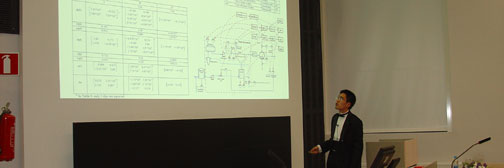| | Year 1999
Ari RantalaIdentification of process disturbances in electrolytic refining of copper
The aim of this thesis was to investigate possibilities for the development of a supervisory level process monitoring system for the copper electrorefining process.
Copper electrorefining is a process where time constants are exceptionally large and variables are strongly correlated. Process control and state identification is in practice based on cathode quality, current efficiency and electrolyte composition monitoring. This leads to a situation where the disturbances affecting the process are noticed after the effects can be detected from the output variables of the process. Because of the slow dynamics of the process, corrective control actions are also noticed after a long time period. These facts have led to the idea of developing a supervisory process monitoring system for the copper electrorefining process.
In the literature part, a description of the copper electrorefining process is given, the most usual disturbance states occurring in the process and factors affecting the development possibilities of those states were studied. Mathematical methods suitable for monitoring, classifying and clustering were also studied. These included multivariable control charts, principal component analysis and partial least squares from the field of multivariable statistics. Self-organizing maps, radial basis function networks and linear vector quantization networks were also considered.
In the experimental part, the most effective process variables were first identified with multivariable statistical analysis of old test plant and laboratory data. As a result, it was concluded that the following variables have the strongest impact on the process: current density, electrolyte temperature, electrolyte glue and arsene(V) concentration and the position of the cathode plate in the cell.
Next, the effects of the chemical quality of anodes on the physical quality of the cathodes were examined with principal component analysis and self-organizing maps. In this work, formation of clusters in the anode quality was the main focus of interest.
It was noticed that during the production of weak quality copper cathodes, chemical quality of the anodes differed from those anodes which were used in the process when good quality cathodes were produced. A combination of principal component analysis and self-organizing map gave the best classification results.
In the last chapter of the experimental part, the structure and function of the supervisory level identification system were outlined.
Deprecated: strlen(): Passing null to parameter #1 ($string) of type string is deprecated in C:\WWWroot\Root\incs\5_theses\theses_new2010.php on line 248
This info last modified 27 Apr 2024 - contact webmaster
|

